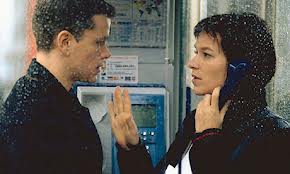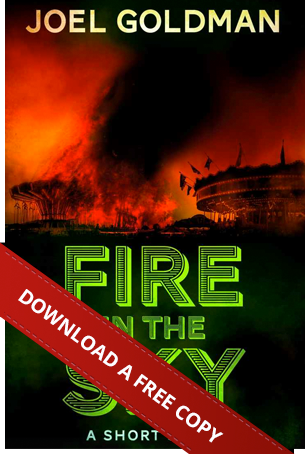The difference between good dialogue and bad dialogue can mean the success or failure of a work of fiction. Whether you’re writing novels, short stories, a script or screenplay, convincing dialogue represents one of the biggest challenges for a writer. For readers, good dialogue contributes greatly to the overall reading experience. Bad dialogue? Well, you may just lose your reader altogether. Case closed.
Solid dialogue is so important that I decided to open my latest legal thriller Stone Cold with these words from its heroine: “Your honor, you can’t let the jury see these photographs, not if my client is going to get a fair trial,” Alex Stone said, thrusting an eight-by-ten glossy toward the judge. “The victim’s severed penis is sticking out of his mouth! But that’s not even the worst one.”
This initial courtroom dialogue achieves many goals. For readers, these lines instantly set the stage – this exchange clearly places the characters in a courtroom setting. Further, we are introduced to the main character, Public Defender Alex Stone. Her words and gesture present her as an impassioned advocate for her client. And, in a broader sense, this opening dialogue sets the mood and tone for all of the action that unfolds over the course of Stone Cold.
What Makes Good Dialogue Good?
Good dialogue should always operate on many levels at once. Remember that every word a character speaks should serve a purpose.
- Do not use dialogue simply to convey superfluous information or provide a break in your narrative. Dialogue should have a purpose: to set the scene, advance the plot, provide insight into characterization, or to foreshadow.
- Keep the character’s voice in mind, but keep it readable. Dialogue doesn’t have to be grammatically correct; it should read like actual speech. Try to strike a balance between realistic speech and readability. If the reader can’t understand the dialogue, the realistic speech fails to serve its purpose.
- Take care when using slang and dialect—a little can go a long way. Don’t use too much slang or too many misspellings in order to create a character’s voice. Also remember to use speech as a characterization tool. Word choice and style tells a reader a lot about a person: appearance, ethnicity, sexuality, background, and morality. In my short story, Knife Fight, the defendant narrates and much of the dialogue reflects his background.
From Knife Fight:
Every day is a knife fight. That’s what I tell my lawyer the first time I meet her.
“Travis,” she say to me, “what am I supposed to do with that?”
“Shit, girl, you my lawyer. You figure it out.”
We in a room at the jail where prisoners meet with they lawyers, a guard watchin’ through a window make sure I don’t climb inside her pants and escape. Hard floor, hard chairs, hard everything.
But don’t talk too much. Sometimes saying nothing, or saying the opposite of what we know a character feels, results in greater impact. Silence, or a pause in a conversation, creates tension and keeps your reader guessing. When I was a trial lawyer, I used well-placed pauses and spaces of silence in my arguments to drive my message home with the judge and jury.
Talking Out Loud – Writing Dialogue to Move Your Reader
You want to ensure that you’ve written convincing dialogue, but how can you be sure? Always read it out loud to hear whether it sounds like natural speech. Even better, grab a few friends and have them read the dialogue aloud to you and remain as objective as possible. Listen for the natural rhythms and flow of conversation. If it sounds awkward, forced or stilted to you, that’s what your readers will notice as well.
It’s essential that you test the dialogue this way. Think about it…I’m a white, successful, Jewish trial attorney by trade. But in my crime novels, I have to include dialogue between people from diverse backgrounds and life experiences. I found it helps to set up the dialogue with some descriptive words about the scene too. Check out this banter, also from the first page of Knife Fight:
Her name Alex Stone, Public Defender. She don’t look like much. Hit me ‘bout at my shoulders. Black hair cut short and tight. Got on black pants, black shirt and one of them six-pointed stars around her neck I seen Jews wear. She skinny and flat like she work out all the time. Got muscles ‘stead of tits. Girl gotta be on the down low.
“You a lesbian?”
She cross her arms. “Yeah.”
“Jew?”
“Two for two.”
“So I got a Jew dyke for a lawyer. This shit is fucked up, man.”
“Yeah, well don’t feel bad. Looks like I’ve got a black client who hates Jews and gays. I guess we’re both fucked.”
I look at her, girl smilin’, maybe playin’ wit me. “You sayin’ you hate blacks?”
Did I hook you? If you want to read more, you can buy it for .99 cents by clicking the Knife Fight link above, or you can download this short story free. It introduces Alex Stone who stars in Stone Cold, the first book in my latest thriller series.
I’d love to hear about your challenges when writing dialogue, or even about dialogue in your favorite (or not so favorite) books.
Have you come across any dialogue snippets that don’t resonate with you in books you’ve read? Share them with me and let’s discuss it.












